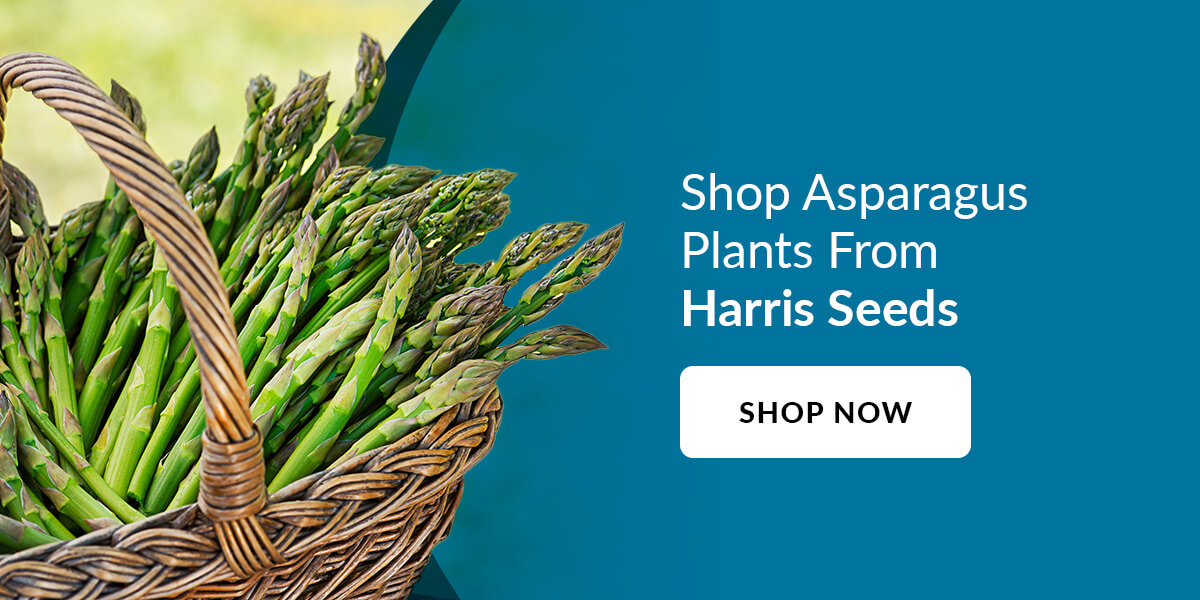
Table of Contents
Asparagus Planting Tips
What Soil Is Best For Asparagus?
Asparagus grows best in well-drained, fertile soils with a pH range of 6.8 to 7.2. Apply enough lime to raise the soil’s pH to the necessary level. Asparagus needs direct sun, so when choosing your site, plan for a permanent spot in a sunny location. Asparagus is a perennial and should not be grown in a container or pot.Should You Fertilize Asparagus?
In early spring, apply a garden fertilizer of 5-10-10 at a rate of 5 lbs. per 100 square inches. Till your soil deeply, working in all of the fertilizer. Make sure your bed is free of weeds, then make furrows about 8-10” deep and 4-5’ apart.How Far Apart Should Asparagus Be Planted?
Plant the asparagus crowns approximately 12-14” apart within the row.How Deep Should You Plant Asparagus?
Cover the crowns with only 2”of soil. As the plant produces ferns, slowly fill in the trench. By the end of summer, the trench should be at soil level.In early August, side-dress the plants with 5-10-10 at a rate of 1 pound per 20 linear feet. Work lightly into soil, being careful not to disturb the crowns and ferns. Allow the ferns to grow all season, keeping the bed weed-free and irrigating as needed.
Asparagus Growing Tips
Your asparagus crown will ship in early spring based on your zip code. At shipping time, your plants will just be emerging from dormancy. Plant them immediately, ideally within 48 hours of receiving them, to avoid any plant injury.How Often Should You Water Asparagus?
Be sure to water your plants regularly in their first season to help get roots established.
Removing Weeds and Grasses
Using weed-free mulch or compost is essential when growing asparagus. Keep weeds from seeding by removing them while young. Clean your gardening tools after weeding so you don't spread weed seed, and keep your beds protected by a perimeter, creating a mowed or mulched barrier around the asparagus.

Asparagus Harvesting Tips
When Should You Harvest Asparagus?
In early spring, you will see tender spears emerging, but resist the urge to harvest them until after the first year. The spears will grow into lacy ferns, which store energy and food for the growing plants. You'll have greater yields and healthier plants in subsequent years if they develop strong roots the first year.2nd Season Asparagus Tips
In their second season, you can begin to harvest your asparagus spears but only for a short time. Cut for about 2 weeks. After that, again allow the plant to grow without harvesting so the plants can continue to develop strong roots and crowns.3rd Season Asparagus Tips
The 3rd season you can harvest the spears for a little longer, up to four weeks. After four weeks stop harvesting and allow the spears to develop into fronds. The following year you should be able to harvest for the entire season.
How To Harvest Asparagus?
Harvest asparagus when the spears are 4-10 inches long. One of the easiest ways to harvest is to simply snap the spear off at its base. Harvest every other day to prevent the spears from becoming fibrous and tough.Post Harvest Asparagus Tips
After harvest, be sure to maintain good growing conditions. Keep the bed weed free and well watered. Allow the ferns to grow throughout the entire season and remove only after they naturally die back. The ferns help nourish the crowns which should increase in size each year.How Much Do Asparagus Plants Yield?
A well-tended planting yields 8 to 10 lbs. or more per 100 square foot of bed, or 24 to 30 pounds per 100’ row.How Long Does Asparagus Produce?
Asparagus will last 15 to 25 years without replanting if it is well cared for and the climate is suitable. It does not do well if summers are extremely hot and long, and winters are mild.More About How to Grow Asparagus
Growing asparagus is possible in most temperate regions, but it tends to thrive in cooler areas and through long winters. The asparagus spears are edible shoots that protrude from the ground, usually emerging from the soil once temperatures exceed 50 degrees Fahrenheit.
A crucial component in asparagus growing is not harvesting it during the first few seasons, allowing the plant to establish itself. Being patient initially can help yield productive asparagus beds for 15 to 20-plus years. With asparagus staying productive for decades, purchasing quality seeds is vital.
Top 3 Asparagus Varieties
Popular asparagus bare roots that growers and gardeners like to buy from Harris Seeds include:
- Asparagus Jersey Knight: This variety is sold as a bare root plant and is all-male, growing three times faster than male-female types. This asparagus is known for being sweet, tender, thick and flavorful.
- Asparagus Purple Passion: This asparagus variety is known for being larger, more tender and sweeter than traditional asparagus, making it a favorite in restaurants. It is productive and reasonably resistant to root/crown rots, fusarium and rust.
- Asparagus Viking KB3: This tasty asparagus variety is vigorous, yielding large loads in various climates. This asparagus type can produce for 20-plus years in the right conditions.
Shop Asparagus Plants From Harris Seeds
Harris Seeds is your trusted asparagus plant distributor. Shop high-quality asparagus plants from our online store!


